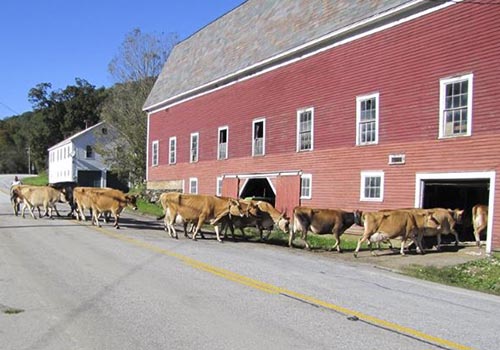If you’re a fan of Morbier, you need to taste Spring Brook Farm’s Ashbrook. This new Vermont cheese, a Morbier lookalike, leaves many examples of the well-known French cheese in the dust.
Morbier is that semisoft cheese from the Franche-Comté region with the ripple of ash in the center. Typically, it is mild and inoffensive, with a handsome appearance but unremarkable aroma and taste. I have had memorable Morbier in the U.S. from the respected affineur (cheese ager) Jean d’Alos, but most other renditions of this cheese leave me cold.
Spring Brook Farm already has a stellar reputation for Reading, its Raclette-style cheese; and for the fabulous Tarentaise, which won Best of Show at last year’s American Cheese Society competition. Cheesemaker Jeremy Stephenson just has the touch.
Tarentaise is a farmstead cheese from the milk of Spring Brook’s own cows. When profits from Tarentaise alone couldn’t support the farm’s philanthropic work—it runs week-long camps for city kids—Stephenson developed Reading using milk purchased from neighbors. But when that commitment led to a milk surplus, Spring Brook needed a third cheese. It had more milk supply than Tarentaise and Reading could absorb.
Milking time at Spring Brook Farm
Stephenson began playing around with new recipes. Retailers had been asking him for a Morbier-style cheese, probably because, like me, they were disappointed with what France sent our way. The recipe took a year or so to refine, but the creamery began selling it for real at the end of last year. I think it’s lovely.
Ashlyn is made from raw Jersey milk and formed in 16- to 18-pound wheels. Did I just write “Ashlyn”? Oops. This cheese debuted under that name, but it is being rechristened Ashbrook because of trademark issues with a Canadian goat cheese. Although Ashlyn may persist on some cheese-shop signage for a while, the cheese now answers to Ashbrook.
In times past, Morbier production called for a two-step process. Curd from the evening milk went into the forms and was topped with ash to protect it. The next day’s morning milking yielded another batch of curds, which went on top. Stephenson tells me that almost nobody does it this way anymore. For Morbier, as for Ashbrook, the wheel is halved horizontally as soon it can hold its shape and the ash is scattered between the halves. Then the wheel is pressed to consolidate it, and the two halves re-knit over the two to three months of maturation.
The wedge I purchased recently had a thin, sticky, flesh-colored rind typical of brine-washed cheeses. Given that the cheese was certainly made with winter milk, the rich yellow color of the paste surprised me. In summer, when the cows are on pasture, the hue will be even deeper. The blue-gray ash line was faint, but Stephenson said he is trying to make it bolder.
Note the roasted-peanut aroma and the dreamy texture. Ashbrook is creamier than Morbier, with none of that fudgy, gummy mouthfeel that can make some washed-rind cheeses unpleasant. I think Stephenson would say that he is still tweaking the recipe (what good cheesemaker ever stops tweaking?), but Ashbrook impresses right out of the gate.
Look for Spring Brook Farm Ashbrook (aka Ashlyn) at Bi-Rite Markets, Cheese Plus, Cowgirl Creamery and Mission Cheese in San Francisco; at Cowgirl Creamery in Point Reyes; Larchmont Village Wine in Los Angeles; Wedge in Reno; Cured in Boulder; and The Fox and the Crow in Fort Collins, CO. Beer lovers, open a Belgian dubbel or tripel; wine fans, try a Pinot Gris.
Ready for Cheese Camp?
Former ACS Best of Show Rogue River Blue (clockwise from upper left) with Matos Cheese Factory St. George and Redwood Hill Farm Camellia
If you are in the cheese business in any way, or thinking about entering the cheese business, you need to be at Cheese Camp 2015, the American Cheese Society’s annual conference, July 29-August 1, in Providence, Rhode Island. That’s a long hike from my West Coast home, but no way would I miss it. I learn so much at this gathering—from the conference sessions and from the conversations. And if you’re merely a cheese enthusiast, you can forego the conference and just attend the Festival of Cheeses on Saturday, August 1. There could be 1,800 cheeses to sample, so pace yourself. Details here.



